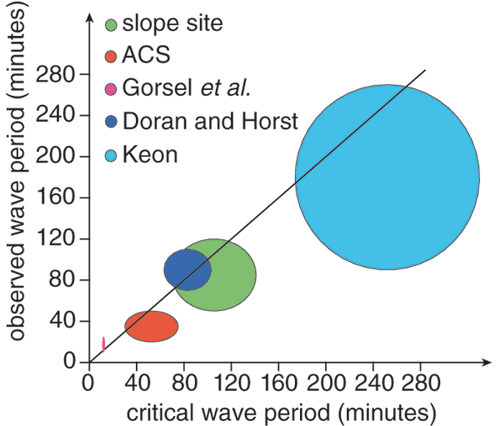
This Article From Issue
September-October 2004
Volume 92, Number 5
DOI: 10.1511/2004.49.0
To the Editors:
David Cacchione and Lincoln Pratson have proposed that internal tidal waves can be a principal factor that determines the angle of oceanic continental slope ("Internal Tides and the Continental Slope," March–April). The authors argue that the continental slopes we see today are close to what one would expect if the semi–diurnal period is the same as the critical period. That is, incessant forcing of semi–diurnal tides over the past hundreds of millions of years has nudged the slope in such a way that the semi–diurnal tides are critical. Since these waves have highest orbital velocities, they have potential for intense sediment suspension activity. This idea is well and good, but one might also ask the question: Can the slope be determined by some other geological process, while the observed coincidence of critical and semi–diurnal frequencies is determined by mixing near the slope that has a feedback effect on oceanic density structure?

We had the opportunity of examining atmospheric data, including our own measurements, taken near mountain slopes under fairly calm weather conditions. At night, the air layer over the slopes becomes strongly stable, thus supporting internal wave activity. The figure shows the measured dominant period as a function of the critical wave period (the data–handling procedure is discussed in Monti, P., et al., 2002, Journal of the Atmospheric Sciences 59(17):2513–2534), and the results strongly suggest that the wave activity near mountain slopes is also strongly correlated with the critical period. The sediment transport and tides are insignificant in the atmospheric case, and the background stratification appears to be adjusting in response to turbulent mixing so that the dominant internal waves near the surface are near critical (and hence maintaining condition for most effective turbulent mixing). If this deduction is to be extended to oceans, one may surmise that, over the years, the near–slope stratification could have been swayed by the internal tide in such a way that the latter is critical and an effective mixer! The sediment suspension perhaps is a pleasant offspring of this phenomenon, rather than a dominant mechanism that determines the slope angle. The true chicken (slope) and egg (stratification) story will unravel as more observations and analyses become available.
H. J. S. Fernando
M. Princevac
Arizona State University
American Scientist Comments and Discussion
To discuss our articles or comment on them, please share them and tag American Scientist on social media platforms. Here are links to our profiles on Twitter, Facebook, and LinkedIn.
If we re-share your post, we will moderate comments/discussion following our comments policy.